
Vicia sativa, known as the common vetch, garden vetch, tare or simply vetch, is a nitrogen-fixing leguminous plant in the family Fabaceae. Although considered a weed when found growing in a cultivated grainfield, this hardy plant is often grown as green manure or livestock fodder.
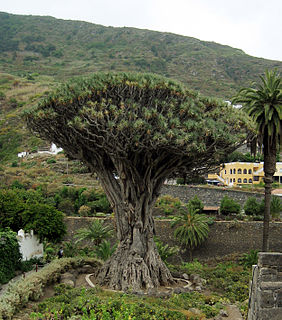
Dracaena draco, the Canary Islands dragon tree or drago, is a subtropical tree in the genus Dracaena, native to the Canary Islands, Cape Verde, Madeira, western Morocco, and is thought to be introduced in the Azores. It is the natural symbol of the island of Tenerife, together with the blue chaffinch. Its closest living relative is the dragon's blood tree of Socotra, Dracaena cinnabari.

Campanula rotundifolia, the harebell, Scottish bluebell, or bluebell of Scotland, is a species of flowering plant in the bellflower family Campanulaceae. This herbaceous perennial is found throughout the temperate regions of the northern hemisphere. In Scotland, it is often known simply as bluebell. It is the floral emblem of Sweden where it is known as small bluebell. It produces its violet-blue, bell-shaped flowers in late summer and autumn.

Linnaea borealis is a species of flowering plant in the family Caprifoliaceae. Until 2013, it was the only species in the genus Linnaea. It is a boreal to subarctic woodland subshrub, commonly known as twinflower.
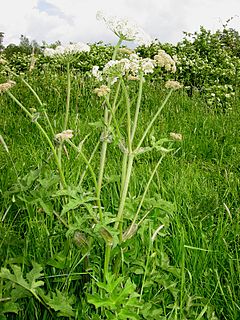
Heracleum sphondylium, commonly known as hogweed, common hogweed or cow parsnip, is a herbaceous perennial or biennial plant, in the umbelliferous family Apiaceae that includes fennel, cow parsley, ground elder and giant hogweed. It is native to Europe and Asia. The common name eltrot may also be applied, but is not specific to this species. Umbelliferous plants are so named because of the umbrella-like arrangement of flowers they produce. The North American species Heracleum maximum is sometimes included as a subspecies of H. sphondylium.

Angophora costata, commonly known as Sydney red gum, rusty gum or smooth-barked apple, is a species of tree that is endemic to eastern Australia. Reaching 30 m (100 ft) in height, the species has distinctive smooth bark that is pinkish or orange-brown when new and fades to grey with age. Its lance-shaped leaves are arranged in opposite pairs along the stems, with white or creamy white flowers appearing from October to December. The flower buds are usually arranged in groups of three, followed by ribbed, oval or bell-shaped fruit.

Banksia drummondii, commonly known as Drummond's dryandra, is a species of shrub that is endemic to Western Australia. It has pinnatifid to pinnatisect leaves, heads of up to one hundred cream-coloured, red and yellow flowers and glabrous fruit.
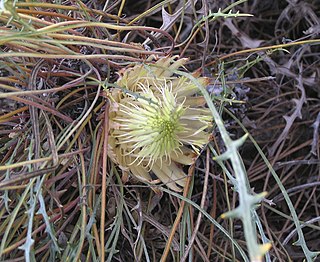
Banksia rufa is a species of prostrate shrub that is endemic to the south-west of Western Australia. It has broadly linear, pinnatifid or pinnatipartite leaves with between five and twenty lobes on each side, yellow, orange or brownish flowers in heads of forty or more, and glabrous, egg-shaped follicles.

Banksia dallanneyi, commonly known as couch honeypot, is a species of prostrate shrub that is endemic to Western Australia. It only has a short above-ground stem, pinnatipartite or pinnatisect leaves, between thirty and seventy variously coloured flowers and glabrous, egg-shaped fruit.
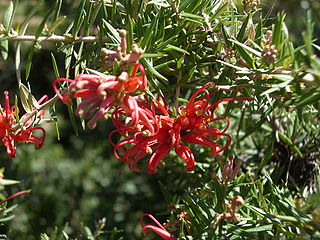
Grevillea juniperina, commonly known as juniper- or juniper-leaf grevillea or prickly spider-flower, is a plant of the family Proteaceae native to eastern New South Wales and southeastern Queensland in Australia. Scottish botanist Robert Brown described the species in 1810, and seven subspecies are recognised. One subspecies, G. j. juniperina, is restricted to Western Sydney and environs and is threatened by loss of habitat and housing development.
Phytophthora cryptogea is a species of water mould in the family Pythiaceae. It is a plant pathogen that infects several species of cultivated plants, including over 40 species of cultivated flowers.

Anthyllis vulneraria, the common kidneyvetch, kidney vetch or woundwort is a medicinal plant native to Europe. The name vulneraria means "wound healer".
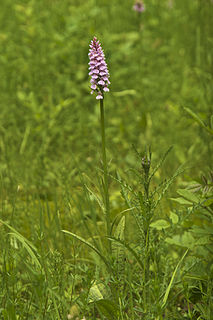
Dactylorhiza maculata, known as the heath spotted-orchid or moorland spotted orchid, is an herbaceous perennial plant of the family Orchidaceae. It is widespread in mountainous regions across much of Europe from Portugal and Iceland east to Russia. It is also found in Algeria, Morocco, and western Siberia.
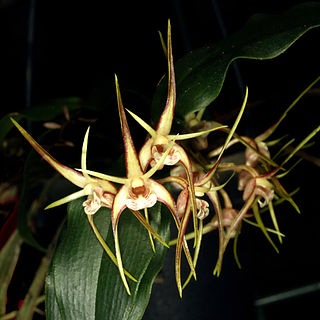
Dendrobium tetragonum, commonly known as the tree spider orchid, is a variable species of epiphytic or lithophytic orchid endemic to eastern Australia. Tree spider orchids are unusual in having pendulous pseudobulbs that are thin and wiry near the base then expand into a fleshy, four-sided upper section before tapering at the tip. There are only a few thin but leathery leaves at the end of the pseudobulbs and up to five flowers on relatively short flowering stems. To allow for the variations in the species there are five subspecies and a variety, some with a unique common name.

Rhamnus alaternus is a species of flowering plant in the buckthorn family Rhamnaceae, known by the common names Italian buckthorn or Mediterranean buckthorn. It is a hardy medium-sized evergreen shrub with fragrant flowers.

Evolvulus is a genus of flowering plants in the Convolvulaceae, the morning glory family. They are known generally as dwarf morning glories. Most all are native to the Americas. There are about 100 species.

Evolvulus alsinoides, commonly known as dwarf morning-glory and slender dwarf morning-glory, is flowering plant from the family Convolvulaceae. It has a natural pantropical distribution encompassing tropical and warm-temperate regions of Australasia, Indomalaya, Polynesia, Sub-Saharan Africa and the Americas.
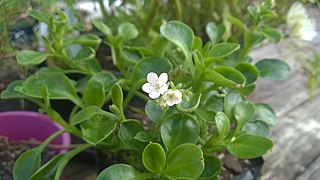
Myosotis pansa subsp. pansa, also known as the Waitakere forget-me-not, is a subspecies of forget-me-not endemic to New Zealand.
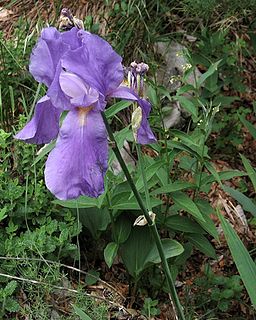
Iris pallida subsp. cengialti is a subspecies in the genus Iris, it is also in the subgenus Iris. It is a rhizomatous perennial, from Italy and Slovenia. It has yellowish-green, glaucous, lanceolate or ensiform leaves, tall stem, green flushed with purple spathes, 2 short branches, 2–3 scented flowers, in shades of violet, blue-violet, deep purple, blue-purple, deep blue-purple, pale purple, deep blue, to mid-blue. It has a yellow or orange tipped beard. It was originally published as Iris cengialti but then re-classified as a subspecies of Iris pallida, and known as Iris pallida subsp. cengialti, but it is often still called Iris cengialti. It is cultivated as an ornamental garden plant in temperate regions.

Iris subbiflora is a plant species in the genus Iris, it is also in the subgenus Iris. It is a rhizomatous perennial, from Portugal and Spain in Europe. It has evergreen broad leaves, forming dense clumps, it has dwarf stems in late spring,, with 1 upright fragrant flower, in shades of purple, light red purple, grey-blue, blue-violet, or dark violet. It has a beard which is generally blue, purple, or violet, but can fade to white, dull yellow, or dark yellow. After being found in 1804, it was once a separate species until the late 70s, when it was reclassified as subspecies of Iris lutescens, and renamed Iris lutescens subsp. subbiflora. But in the 80s it was returned to an independent species but some authors and references still class the species as a synonym or subspecies. It is cultivated as an ornamental plant in temperate regions.


























